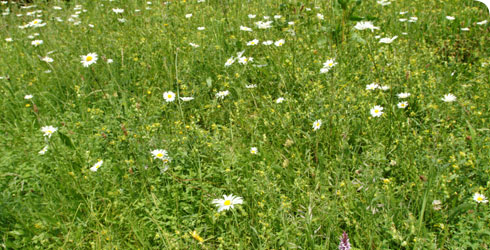Meadow
Meadows are open areas of grassland, untouched by artificial fertilisers and closed to grazing animals during the spring and summer months. They are characterised by a wealth of colourful flowers before they are cut and turned back into grazing land during the winter. With their variety of wild flowers and grasses they form an important habitat for many species of insect and other invertebrates.
History
Flower-rich meadows have evolved over hundreds of years through a combination of hay cutting and winter grazing. While pasture is grassland that is generally grazed throughout the year, meadows are closed to animal grazing in spring. The plants are left to grow and set seed until mid to late summer when the hay crop is harvested. The cut hay is left to dry for a few days before being baled up, collected and stored for use as animal fodder. After a few weeks growth the meadows are then grazed from late summer or autumn until the following spring.
Features
The plant species found in meadows varies according to local climate and soil conditions as well as the timing of cutting and grazing.
Meadow buttercup (Ranunculus acris), oxeye daisy (Leucanthemum vulgare), common knapweed (Centaurea nigra), yellow rattle (Rhinanthus minor), sweet vernal grass (Anthoxanthum odoratum) and red fescue (Festuca rubra) are just some of the many colourful plants to be found in traditionally-managed hay meadows.
Habitat for wildlife
Apart from the colour and beauty of the plants, meadows are valuable for a wide range of insects. In the spring, orange-tip (Anthocharis cardamines) butterflies lay their eggs on Cuckooflower (Cardamine pratensis). Meadow browns (Maniola jurtina) and skipper butterflies depend on different grasses, such as cock's-foot (Dactylis glomerata) and Yorkshire fog (Holcus lanatus), to lay their eggs in summer, while bumblebees and hoverflies depend on the many nectar-rich flowers.
Habitat loss
Most of Britain's meadows were destroyed by the intensification of farming methods after the Second World War. As hedges were removed to increase the size of fields, flower-rich meadows were also ploughed and cultivated for arable crops. Others were ploughed and re-sown as 'improved' grassland, which is a mixture of two main species, rye grass and clover. Growth in this environment is encouraged by chemical fertilisers. Many meadows have also disappeared through urban expansion. By 1984 the total area of meadowland was estimated at just 3% of the 1930 level.
Managing meadows
Meadows on some of the less accessible slopes of chalk grassland remain unharmed, as do some damp and isolated meadows. A few have been protected as nature reserves with traditional management methods. Increasingly, meadow creation schemes are reversing the trend of 'improved' grassland by stripping and re-sowing with seeds from unimproved meadows.
Unmanaged grassland will gradually revert to scrub and eventually to woodland.
Meadow in the Museum's Wildlife Garden
The Wildlife Garden meadow includes a colourful mix of plants including:
- buttercups
- meadow cranesbill (Geranium pratense)
- betony (Stachys officinalis)
- meadow vetchling (Lathyrus pratensis)
- common knapweed
- bird's-foot-trefoil (Lotus corniculatus)
- yellow rattle
Our meadow attracts many insects including common blue butterfly (Polyommatus icarus). Its caterpillar feeds off bird's-foot-trefoil. During May and June azure damselflies (Coenagrion puella) may also be seen foraging amongst a variety of plants. Tiny froglets and toadlets migrate to the meadow in June and July. Our sheep come and graze during late summer and early autumn.
Meadow in your garden
Small meadows can be created in gardens instead of lawns, or alongside them. It is unlikely that a garden meadow will be large enough to feed meadow butterfly larvae but the flowers are an attractive addition on their own and are refuges for a number of invertebrates. A lawn fringed with oxeye daisies and buttercups reminds us of the countryside in early summer. Many specialist nurseries sell native meadow plants and seeds.
Wildlife Garden blog

Keep up to date with what’s happening in the Museum’s Wildlife Garden and discover some of the latest sightings in this tranquil haven.

